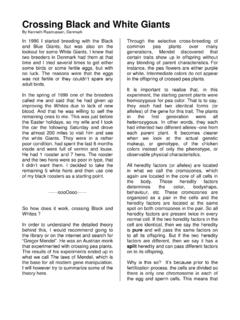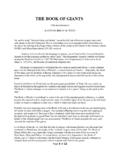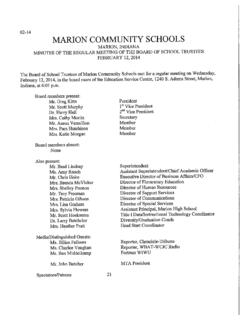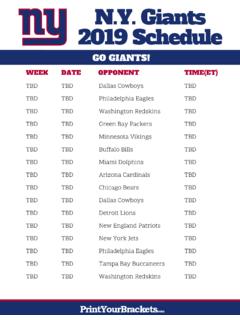Transcription of NETWORK NEUTRALITY, BROADBAND DISCRIMINATION
1 141 NETWORK NEUTRALITY, BROADBAND DISCRIMINATION TIM WU* INTRODUCTION Communications regulators over the next decade will spend increasing time on conflicts between the private interests of BROADBAND providers and the public s interest in a competitive innovation environment centered on the Internet. As the policy questions this conflict raises are basic to communications policy, they are likely to reappear in many different forms. So far, the first major appearance has come in the open access (or multiple access ) debate, over the desirability of allowing vertical integration between Internet Service Providers and cable Proponents of open access see it as a structural remedy to guard against an erosion of the neutrality of the NETWORK as between competing content and applications.
2 Critics, meanwhile, have taken open-access regulation as unnecessary and likely to slow the pace of BROADBAND deployment. This paper takes a more general perspective. The questions raised in discussions of open access and NETWORK neutrality are basic to both * Associate Professor of Law, University of Virginia Law School. I am grateful for comments on this paper from Tom Nachbar, Lawrence Lessig, Mark Lemley, Glen Robinson along with participants at the 2003 Silicon Flatirons Conference and the 2003 University of Ottawa Tory Law Speaker Series. The ideas in this paper were aided by discussions of NETWORK neutrality questions with individuals at the Federal Communications Commission and Congress, including Jordan Goldstein, James Assey, Jessica Rosenworcel and Commissioner Michael Copps.
3 1. See generally Joseph Farrell & Philip J. Weiser, Modularity, Vertical Integration, and Open Access Policies: Towards a Convergence of Antitrust and Regulation in the Internet Age, 17 HARV. & TECH. (forthcoming 2003), available at http://repositories. (last visited Sept. 24, 2003); Glenn A. Woroch, Open Access Rules and the BROADBAND Race, 2002 L. REV. MICH. ST. U. DET. 719 (2002); Glen O. Robinson, On Refusing to Deal with Rivals, 87 CORNELL L. REV. 1177, 1224-27 (2002); Mark A. Lemley & Lawrence Lessig, The End of End-to-End: Preserving the Architecture of the Internet in the BROADBAND Era, 48 UCLA L. REV. 925 (2001); Phil Weiser, Paradigm Changes in Telecommunications Regulation, 71 U. COLO. L. REV.
4 819 (2000); James B. Speta, Handicapping the Race for the Last Mile? A Critique of Open Access Rules for BROADBAND Platforms, 17 YALE. J. ON REG. 39, 77-90 (2000). 142 J. ON TELECOMM. & HIGH TECH. L. [Vol. 2 telecommunications and innovation policy. The promotion of NETWORK neutrality is no different than the challenge of promoting fair evolutionary competition in any privately owned environment, whether a telephone NETWORK , operating system, or even a retail store. Government regulation in such contexts invariably tries to help ensure that the short-term interests of the owner do not prevent the best products or applications becoming available to end-users.]
5 The same interest animates the promotion of NETWORK neutrality: preserving a Darwinian competition among every conceivable use of the Internet so that the only the best survive. Given the likely recurrence of these kinds of questions, this paper compares three general approaches to the regulation of BROADBAND providers: structural remedies, a non- DISCRIMINATION regime, and self- or non-regulation. It questions, first, the merits of structural remedies like open access as a means for promoting NETWORK innovation in favor of less intrusive models. While structural restrictions like open access may serve other interests, as a remedy to promote the neutrality of the NETWORK they are potentially counterproductive. Proponents of open access have generally overlooked the fact that, to the extent an open access rule inhibits vertical relationships, it can help maintain the Internet s greatest deviation from NETWORK neutrality.
6 That deviation is favoritism of data applications, as a class, over latency-sensitive applications involving voice or video. There is also reason to believe that open access alone can be an insufficient remedy for many of the likely instances of NETWORK DISCRIMINATION . The preferable framework for ensuring NETWORK neutrality, I argue, forgoes structural remedies for a direct scrutiny of BROADBAND DISCRIMINATION . The link between anti- DISCRIMINATION regulations and NETWORK innovation are as old as the Hush-a-Phone2 and Carterfone3 decisions, which controlled AT&T s efforts to destroy innovative NETWORK attachments. The basic principle behind a NETWORK anti- DISCRIMINATION regime is to give users the right to use non-harmful NETWORK attachments or applications, and give innovators the corresponding freedom to supply them.
7 Such a regime avoids some of the costs of structural regulation by allowing for efficient vertical integration so long as the rights granted to the users of the NETWORK are not compromised. But might NETWORK neutrality be accomplished without any regulation at all? Basic economic theory suggests that operators have a long-term interest coincident with the public: both should want a neutral platform that supports the emergence of the very best applications. 2. Hush-A-Phone Corp. v. United States, 238 266 ( Cir. 1956). 3. Use of the Carterfone Device in Message Toll Tel. Serv., 31 420 (1968). 2003] NETWORK NEUTRALITY 143 However the evidence suggests the operators may have paid less attention to their long-term interests than might be ideal.
8 A 2002 survey of operator practices conducted for this paper suggests a tendency to favor short-term In that year, evidence of a DISCRIMINATION problem became clear from several sources, including consumer complaints about operators who ban classes of applications or equipment, like servers, Virtual Private Networks, or WiFi devices,5 and in filings at the Federal Communications Commission by application The survey in this paper shows that operators indeed had implemented significant contractual and architectural limits on certain classes of applications. Operators showed an unfortunate tendency to want to ban new or emerging applications or NETWORK attachments, like WiFi devices or Virtual Private Networks, perhaps out of suspicion or an (often futile) interest in price- DISCRIMINATION .
9 On the whole the evidence suggests that the operators were often pursuing legitimate goals, such as price DISCRIMINATION and bandwidth management. The problem was the use of methods, like bans on certain forms of applications, which are likely to distort the market and the future of application development. In short, the recent historical record gives good reason to question the efficacy of self-regulation in this area. I don t want to suggest that operators are somehow incapable of understanding their long-term interests. Yet, when we return to the open access debate, one account of the utility of the debate is that it p l a y e d a n i m p o r t a n t i n f o r m a t i o n a l r o l e -----the debate itself helped cable operators evaluate their long-term self-interests, and many have chosen to allow rival ISPs access to their networks, for a variety of Even strong believers in deregulation and the advantages of vertical integration recognize that incumbents may occasionally become set in their In this respect, one of the functions of raising issues of BROADBAND DISCRIMINATION is to challenge BROADBAND operators to ask whether applications restrictions are a good long-term policy.
10 Indeed many of the improvements in operator behavior in the year 2003 may be 4. See infra Appendix. 5. Complaints about restrictions on BROADBAND applications like filesharing applications or VPNs are common on discussion forums like DSL Reports. See, , BROADBAND REPORTS, at ,3775421;mode=flat;root=sware (July, 2002). 6. See Comments of the High Tech BROADBAND Coalition, In re: Inquiry Concerning High-Speed Access to the Internet Over Cable and Other Facilities (filed June 18, 2002), available at ; see also FCC Ex Parte Letter, Aug. 22 2003, available at 7. For example, AT&T BROADBAND has recently begun to open parts of its NETWORK to ISP competition. See Peter J. Howe, Earthlink Debuts On AT&T Networks Offers High-Speed Internet Service, BOSTON GLOBE, Oct.






